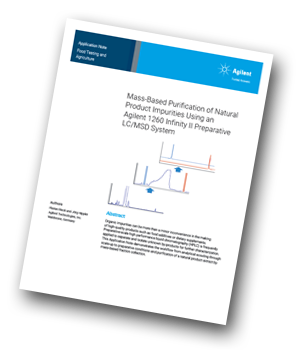In this application note Agilent describes the mass-based purification of natural product impurities using an Agilent 1260 Infinity II Preparative LC/MSD System.

 Abstract
Abstract
Organic impurities can be more than a minor inconvenience in the making of high‑quality products such as food additives or dietary supplements. Preparative‑scale high performance liquid chromatography (HPLC) is frequently applied to separate and isolate unknown by-products for further characterization. This application note demonstrates the workflow from analytical scouting through scale-up to preparative conditions and purification of a natural product extract by mass-based fraction collection.
Introduction
Monitoring organic impurities is a critical issue in the pharmaceutical industry, as the presence of unwanted chemicals may, even in small amounts, influence the efficacy and safety of pharmaceutical products. According to regulations, for example the ICH Guidance for Industry Q3A, impurities need to be identified and characterized when exceeding a certain threshold. However, it is not only the pharmaceutical industry that needs to be aware of organic impurities. To deliver safe and high-quality products, dietary supplements and foodstuffs based on extracts of natural products need to be monitored in a similar manner. The isolation of unknown impurities is crucial for identification and thorough characterization concerning biological activity and toxicity of a compound. Separation and isolation of impurities can be carried out with preparative-scale HPLC, coupled to an ultraviolet (UV) detector and a mass spectrometer (MS). A mass selective detector (MSD) was used for highly specific detection and fraction triggering of the unknown compounds.
Fraction collection
Peak detection and fraction collection were performed using the UV and MSD signals with the AND trigger combination. Using the 1290 Infinity II Preparative Open-Bed Fraction Collector enabled selection of fraction tubes that suited the flow rate and expected fraction volumes of the method.
Results and Discussion
Analytical scouting
The concentrated extract was diluted tenfold with water, and separated on an analytical LC/MSD system. Under these conditions, the main compound was still overloading the column, whereas all impurities were sufficiently resolved. Using the positive scan signal of the MSD, target ions of m/z 823.4 and m/z 839.4 were identified for unknown impurities 1 and 2, respectively. These two target ions were then constantly monitored as signals 2 and 3 of the MSD, which was set to selected ion monitoring (SIM) mode.
Preparative run and fraction collection
Based on the analytical results, the separation of the concentrated sample was scaled up to preparative conditions using the same column type as the analytical run, but with a larger inside diameter. This linear scale-up allowed a reproduction of all relevant retention times within a margin of 0.2 minutes.
Conclusion
This Application Note demonstrates a workflow from analytical scouting to preparative purification using a 1260 Infinity II LC/MSD System and a 1260 Infinity II Preparative LC/MSD System. A natural product extract with two unknown impurities was analysed on an analytical system first. Highly loadable Agilent Prep-C18 stationary phases available in matching dimensions facilitated linear scale-up to preparative conditions with reproducible separation of the target compounds. Fraction triggering by UV and MSD enabled highly specific collection and yielded pure fractions suitable for further analyses to characterize the two unknown impurities of the extract.




